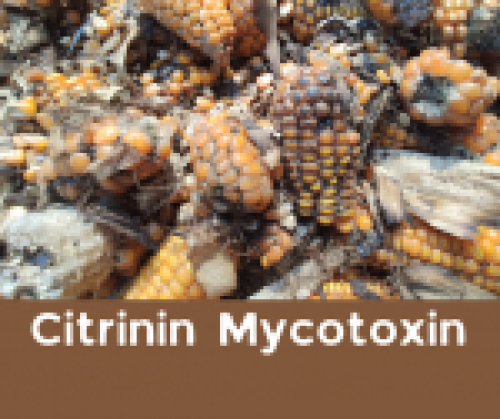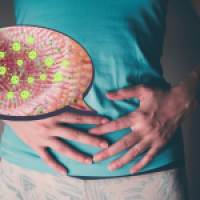Understanding the Citrinin Mycotoxin

What is Citrinin and Why Should You Be Concerned?
Citrinin is a type of mycotoxin, which is a harmful substance produced by certain types of mold. Specifically, this toxic compound is created by fungi from the Penicillium, Aspergillus, and Monascus genera.
Mycotoxins like Citrinin can grow on different food products, including grains, cereals, and fermented foods. In addition, Citrinin can also be found in buildings that have been damaged by water, especially when growing alongside another dangerous mycotoxin called Ochratoxin. Scientists and health professionals are increasingly concerned about Citrinin because of its potential to damage the kidneys and liver, making it an important issue for anyone concerned about their health.
How Citrinin Enters Your Body
Mold thrives in warm, humid environments, and when it contaminates food or building materials, people can be exposed to Citrinin in several ways. You might ingest it by eating contaminated food, inhale it from moldy indoor air, or absorb it through your skin if you come into contact with affected surfaces. Since exposure to this toxin can lead to serious health problems, food safety organizations and regulatory agencies carefully monitor Citrinin levels in food products to help prevent widespread contamination.
The Effects of Citrinin on Your Health
Organ Damage and Mitochondrial Dysfunction
Citrinin has been linked to kidney and liver damage, known as nephrotoxicity and hepatotoxicity, respectively.
The kidneys, which filter waste from the blood, are particularly vulnerable to Citrinin’s harmful effects. This toxin can interfere with how kidney cells function, leading to inflammation, scarring, and even kidney failure over time. In addition to kidney damage, Citrinin is known to harm the liver, another essential organ responsible for detoxification and digestion.
Another major concern is mitochondrial dysfunction. Mitochondria are the energy powerhouses of our cells, and when they don’t work properly, it can lead to widespread health issues. Since organs like the heart, digestive system, and reproductive organs require a lot of energy, Citrinin exposure can lead to heart palpitations, digestive disorders, and fertility problems.
Mold Sources That Produce Citrinin
Citrinin is commonly found in molds such as:
-
Aspergillus species (including Aspergillus niger, A. awentil, A. ostianus, A. fumigatus, A. niveus, A. awamori, A. parasiticus)
-
Penicillium species (including Penicillium citrinum and P. expansum)
-
Monascus species
These molds can grow on various surfaces, including building materials such as wallpaper, wood, drywall, linoleum, and insulation paper. When these surfaces are exposed to moisture, they provide an ideal breeding ground for Citrinin-producing fungi.
Symptoms of Citrinin Exposure
The symptoms of Citrinin toxicity can affect multiple organ systems and vary depending on the level and duration of exposure. Some of the most common symptoms include:
-
Fatigue and muscle pain
-
Kidney and urinary problems (including frequent urination, urinary pain, nephrogenic diabetes insipidus, and swelling)
-
Digestive issues (such as reflux, nausea, vomiting, diarrhea, ulcers, and blood in the stool)
-
Food and chemical sensitivities
-
Breathing problems (including shortness of breath and chest pain)
-
Heart-related symptoms (such as palpitations)
-
Reproductive issues (including menstrual cycle changes, miscarriage, and infertility in both men and women)
How to Reduce Citrinin Exposure and Support Detoxification
If you suspect you have been exposed to Citrinin, there are several dietary and lifestyle changes that may help support your body’s natural detoxification processes.
Therapeutic Diet for Mycotoxin Detox
-
Avoid grains, as they are commonly contaminated with mold toxins.
-
Eat foods rich in pelargonidin, an antioxidant that supports liver health. These include radishes and orange-red fruits and vegetables.
-
Incorporate butyrate and sulforaphane-rich foods, such as butter, cabbage, radicchio, broccoli, Brussels sprouts, and the white part of spring onions. Butyrate helps protect the gut lining and supports detoxification. Sulforaphane is a sulfur-rich compound found in cruciferous vegetables that has antioxidant, anti-inflammatory, and antimicrobial properties.
-
Consume insoluble fiber as a binder by adding 2 tablespoons of ground organic seeds (such as flaxseeds or chia seeds) to your diet. Insoluble fiber helps bind toxins and supports reproductive organ health.
-
Drink green tea to help reduce skeletal muscle fatigue, a symptom linked to Citrinin exposure.
Supportive Supplements
-
Glutathione and its precursors (NAC, ALA, Selenium) help detoxify the body and support liver function.
-
Alpha-lipoic acid (ALA), specifically the R-Lipoic acid form, is known for its antioxidant benefits.
- Selenium to help with thyroid hormone support to fuel your body to perform detoxification.
-
Resveratrol, grape seed extract, and vitamin E (tocotrienols) offer additional cellular protection.
-
Melatonin helps regulate sleep and repair oxidative damage caused by toxins.
-
Homeopathic vasopressin may provide additional kidney support.
Coenzyme Q10 (CoQ10)
-
CoQ10 is another important nutrient that supports mitochondrial function and helps reduce oxidative stress in the body.
Take Control of Your Health with Functional Medicine
If you are experiencing symptoms that could be related to mold exposure and Citrinin toxicity, it is important to seek expert guidance. Functional medicine takes a whole-body approach to health, identifying the root causes of illness rather than just treating symptoms. At Intentional Wellness, Shannon specializes in helping individuals navigate complex health challenges, including mycotoxin exposure. She can provide personalized strategies to help you detoxify, heal, and regain energy. Sign up today for a functional medicine consultation and take the first step toward better health!
References
-
Bennett, J. W., & Klich, M. (2003). Mycotoxins. Clinical Microbiology Reviews, 16(3), 497–516.
-
Hope, J. (2013). A review of the mechanism of injury and treatment approaches for illness resulting from exposure to water-damaged buildings, mold, and mycotoxins. The Scientific World Journal, 2013.
-
Gallo, A., & Ferrara, M. (2016). Mycotoxins and food safety: New advances in their study. Frontiers in Microbiology, 7, 48.

Further Reading: Mold and Mycotoxins
- Recognizing the Symptoms of Mold Toxicity
- How mycotoxins impact our energy production and mitochondria
- Mold: A frequently overlooked cause of invisible illness
- Mycotoxin Binders
- Understanding the Citrinin Mycotoxin
- Could mold be causing your Mast Cell Disorder?
- How mycotoxins impact our energy production and mitochondria
- Why Mold Detox is Harder with MCAS



